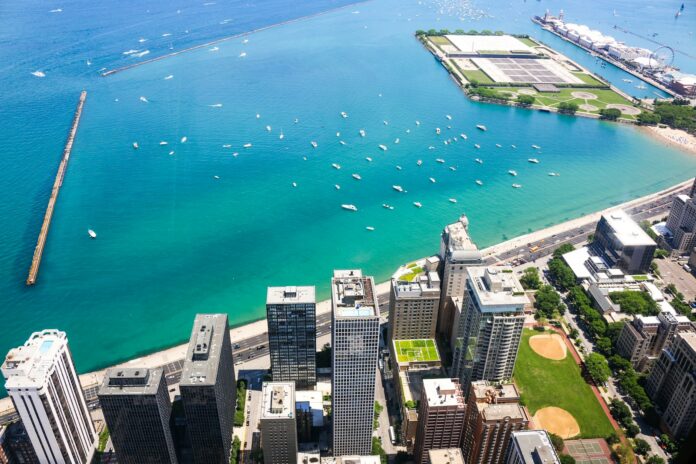Chicago, often referred to as the architectural capital of the United States, is a city known for its stunning skyline, historical buildings, and innovative designs. A Chicago Lake and River Architecture Tour provides the perfect opportunity to immerse yourself in the city’s architectural wonders from a unique perspective—by boat. This tour offers breathtaking views of Chicago’s iconic structures from both its famous Lake Michigan and the Chicago River, blending history, art, and engineering into an unforgettable experience.
1. Introduction to Chicago’s Architectural Legacy
Chicago’s rich architectural history dates back to the late 19th century, following the devastating Great Chicago Fire of 1871, which cleared much of the city’s wooden buildings and paved the way for new urban development. This rebuilding effort attracted world-renowned architects and led to the city becoming a pioneer of modern architecture. Skyscrapers, the invention of the Chicago School, and the embrace of innovative materials such as steel are just some of the contributions the city has made to global architecture.
A. The Significance of Chicago’s Skyline
Today, Chicago’s skyline is dotted with world-class buildings that reflect a variety of architectural styles—from the classic Art Deco structures to the sleek, modern skyscrapers of the 21st century. Many of these architectural marvels sit along the shores of Lake Michigan or line the Chicago River, making a water-based tour the best way to see the city’s architectural highlights.
2. Starting on Lake Michigan: A View from the Great Lakes
The journey begins on Lake Michigan, one of North America’s Great Lakes and an integral part of Chicago’s identity. Cruising along the lake offers stunning panoramic views of the city’s skyline and its most iconic buildings.
A. The Navy Pier
One of the first landmarks you’ll pass is the Navy Pier, a bustling attraction that extends into the lake. Originally built in 1916 as a shipping and recreational facility, Navy Pier is now home to entertainment venues, restaurants, and the famous Centennial Wheel. From the boat, you’ll have the perfect vantage point to appreciate its grand scale and cultural significance to the city.
B. Willis Tower and Hancock Center
As your boat glides across the waters of Lake Michigan, you’ll have unobstructed views of two of Chicago’s tallest buildings—the Willis Tower and the John Hancock Center. The Willis Tower, once the tallest building in the world, still impresses with its height of 1,451 feet and bold black steel facade. Meanwhile, the John Hancock Center is a prime example of the brutalist architectural style, recognized for its cross-braced exterior that gives it a strikingly powerful appearance.
3. Entering the Chicago River: An Architectural Wonderland
After taking in the expansive views from Lake Michigan, the tour will move into the Chicago River, where you’ll experience the city’s architectural gems up close. The Chicago River snakes through the heart of downtown, passing by some of the most significant buildings in the history of American architecture.
A. The Wrigley Building and Tribune Tower
As you enter the river, two of Chicago’s most iconic buildings come into view—the Wrigley Building and the Tribune Tower. The Wrigley Building, constructed in the 1920s, is a Spanish Revival masterpiece that dazzles with its white terra cotta facade. It stands as a symbol of Chicago’s commercial power during the early 20th century.
Right next to it is the Tribune Tower, a prime example of neo-Gothic architecture. Completed in 1925, this building was the result of an international competition to design the most beautiful office building in the world. Its ornate details, spires, and buttresses reflect its Gothic inspiration and make it one of the most admired buildings in Chicago.
B. Marina City: The “Corn Cobs”
Further along the river, you’ll encounter the eye-catching twin towers of Marina City, colloquially known as the “corn cobs” because of their distinctive rounded shape. Designed by architect Bertrand Goldberg in the 1960s, these buildings are iconic examples of mid-century modern architecture and were among the first mixed-use developments in the United States, combining residential, commercial, and entertainment spaces in one complex.
C. The Merchandise Mart
One of the most massive buildings on the tour, the Merchandise Mart occupies over four million square feet of space. Built in 1930, it was once the largest building in the world. This Art Deco masterpiece was designed to serve as a wholesale marketplace and is now home to tech companies, showrooms, and a variety of businesses. Its sheer size and intricate detailing make it one of the key highlights of any architecture tour.
4. The Bridges of the Chicago River
One of the unique aspects of the Chicago River Architecture Tour is the opportunity to sail beneath the city’s many movable bridges. Chicago is home to more movable bridges than any other city in the world, with over 40 bridges spanning the river.
A. The Historic DuSable Bridge
The DuSable Bridge, formerly known as the Michigan Avenue Bridge, is one of the most significant in the city. This bascule bridge, completed in 1920, connects the north and south sides of Chicago and serves as a major thoroughfare for the city. As your boat passes underneath, you can admire the intricate details of the bridge’s architecture and its historical significance.
B. The Kinzie Street Railroad Bridge
Another notable bridge along the tour is the Kinzie Street Railroad Bridge, one of the last remaining vertical-lift bridges in Chicago. This bridge, though no longer in use, stands as a monument to Chicago’s industrial past and serves as a reminder of the city’s once-thriving railroad industry.
5. The Evolution of Chicago’s Architecture
As the tour continues, you’ll witness how Chicago’s architecture has evolved from the days of early skyscrapers to the modern, eco-friendly buildings of today. Chicago has been at the forefront of architectural innovation for over a century, and its influence can be seen in cities around the world.
A. Aqua Tower
Designed by architect Jeanne Gang, the Aqua Tower is one of Chicago’s most striking modern buildings. Its undulating balconies create a wave-like appearance that reflects its name and its proximity to Lake Michigan. Completed in 2010, the Aqua Tower is a perfect example of how modern architects continue to push boundaries in design and engineering.
B. 150 North Riverside
Another modern marvel is 150 North Riverside, an engineering feat that stands on a narrow strip of land between the river and a major rail line. Its innovative design features a tapered base, allowing the building to rise dramatically without taking up much ground space. This sleek, glass-clad tower is a symbol of Chicago’s forward-thinking architectural approach.
6. Practical Information for Your Architecture Tour
A. Best Time to Visit
The Chicago Lake and River Architecture Tour is available year-round, but the best time to experience the tour is during the warmer months from April to October. During this time, you’ll be able to enjoy the open-air boats and take full advantage of the sunny weather and clear skies.
B. What to Bring
- Sunscreen and sunglasses: The sun can be quite strong, especially when reflecting off the water.
- Camera: The views of Chicago’s skyline and architectural wonders are truly spectacular, so don’t forget to bring a camera to capture the moment.
- Comfortable clothing: Depending on the weather, you may want to bring a light jacket or sweater, especially for evening tours.
C. Booking Your Tour
To book your Chicago Lake and River Architecture Tour, visit Viator. Tours generally last about 90 minutes and include an expert guide who will share fascinating insights into Chicago’s architectural history and its most famous buildings.
7. Conclusion: The Perfect Blend of History, Art, and Innovation
A Chicago Lake and River Architecture Tour offers an unparalleled perspective on the city’s rich architectural heritage. From the towering skyscrapers that define its skyline to the intricate details of its historical buildings, Chicago’s architecture tells a story of innovation, resilience, and artistic vision. Whether you’re a history buff, an architecture enthusiast, or simply someone looking to experience Chicago’s beauty from a new angle, this tour promises to be an unforgettable adventure.
For more travel insights and guides, visit Izase.
Disclaimer
This tour information is provided to the best of our knowledge. Please check the official booking page on Viator for the most accurate and up-to-date details on tour availability, schedules, and prices.
MORE FROM IZASE


